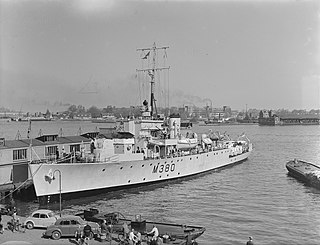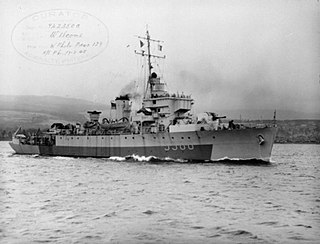
HMS Duncan was the fifth RN ship named after Admiral Adam Duncan. She was a Blackwood-class frigate of the Royal Navy that served in the Cod Wars.

The Isles-class trawlers were a class of naval trawler used by the Royal Navy, Royal Canadian Navy and Royal New Zealand Navy during World War II.

HMS Venerable (1899) was a member of the London class of pre-dreadnought battleships built for the British Royal Navy. The Londons were near repeats of the preceding Formidable-class battleships, but with modified armour protection. Venerable's main battery consisted of four 12-inch (305-mm) guns, and she had top speed of 18 knots. The ship was laid down in January 1899, was launched in November that year, and was completed in November 1902. Commissioned that month, Venerable served in the Mediterranean Fleet until 1908, and was subsequently recommissioned into the Channel Fleet. Following a major refit in 1909, she served with the Atlantic and Home Fleets.

HMS Mariner was a reciprocating engine-powered Algerine-class minesweeper during the Second World War. Laid down as HMCS Kincardine for the Royal Canadian Navy she was transferred on completion to the Royal Navy as HMS Mariner. She survived the war and was sold to Myanmar in 1958 as Yang Myo Aung.

HMS Tyne is a River-class offshore patrol vessel built by Vosper Thornycroft in Southampton for the Royal Navy to serve as a fishery protection unit within the United Kingdom's waters along with her two sister ships Mersey and Severn. All three were commissioned into service in 2003 to replace the five older Island-class patrol vessels.

HMS Diomede was a Danae-class cruiser of the Royal Navy. Constructed at Vickers Armstrong, Barrow, she was constructed too late to take part in World War I and was completed at the Royal Dockyard, Portsmouth. Between the wars, she served on the China Station, Pacific waters, East Indies Waters and from 1936 onwards, in reserve. In World War II she performed four years of arduous war duty, during which time she captured the German blockade runner Idarwald. Between 22 July 1942 and 24 September 1943 she was converted to a training ship at Rosyth Dockyard. In 1945 she was placed in reserve and scrapped a year later.

HMS Russell was one of a dozen Blackwood-class frigates of second-rate anti-submarine frigates built for the British Royal Navy during the 1950s. She was named for Edward Russell, 1st Earl of Orford, commander at the Battle of Barfleur in 1692.

Godetia (A960) was a command and logistical support ship of the Belgian Naval Component, launched on 7 December 1965 at the Boelwerf in Temse and entered service on 2 June 1966. The patronage of Godetia was accepted by the city of Ostend. She was the first of two support ships acquired to replace World War II-era ships. Used primarily to provide logistic support to Belgium's fleet of minesweepers, Godetia has also seen service as a training ship, royal yacht and fisheries protection. The vessel has served with NATO's Standing NATO Mine Countermeasures Group 1 in the Baltic and North seas. In June 2021, Godetia was taken out of service.

BNS Gomati is an Island-class offshore patrol vessel of the Bangladesh Navy. She was originally built as a Fishery Protection Vessel for the British Royal Navy, entering service as HMS Anglesey in 1979. She was sold to Bangladesh in 2002, entering service in 2003.

BNS Shaheed Ruhul Amin was an Island-class offshore patrol vessel of the Bangladesh Navy used as a training ship. She was built and served as a Royal Navy Island-class patrol vessel HMS Jersey (P295) from 1977 to 1993.
HMS Hodgeston was a Ton-class minesweeper which saw service with the Royal Navy during the Cold War. Built by Fleetlands Shipyard, she was launched on 6 April 1954 and broken up in 1988.

The Overseas Patrol Squadron is a front-line squadron of the Royal Navy with responsibility for patrolling the UK's Extended Fisheries Zone, both at home and around British Overseas Territories. The squadron, with headquarters at HMNB Portsmouth, is equipped with eight of the River-class patrol vessels.

HMS Welcome was a reciprocating engine-powered Algerine-class minesweeper built for the Royal Navy during the Second World War. She survived the war and was scrapped in 1962.
HMS Cordella was a Royal Navy auxiliary mine countermeasures vessel that served during the Falklands War as part of 11th MCM Squadron.

HMS Chelmer was a Thornycroft-type River-Class destroyer ordered by the Royal Navy under the 1903–1904 Naval Estimates. Named after the River Chelmer in eastern England, north-east of London, she was the first ship to carry this name in the Royal Navy.
HMS Wave was a reciprocating engine-powered Algerine-class minesweeper built for the Royal Navy during the Second World War. She survived the war and was scrapped, in 1962.
HMS Leda was an Alarm-class torpedo gunboat of the British Royal Navy. She was built by Sheerness Dockyard from 1891–1893. She was converted to a minesweeper in 1908–1909 and continued these duties during the First World War. Leda was scrapped in 1922.
HMS Stubbington was a Ton-class minesweeper which saw service with the Royal Navy during the Cold War. Built by Camper & Nicholson, Portsmouth, she was launched on 8 August 1956. She served as a minesweeper in the Mediterranean and the Middle East in the 1950s and 1960s, and in the Royal Navy Reserve under the name HMS Montrose from 1972 to 1976. She then was used for Fishery Protection duties. Stubbington was broken up in 1989.
Junella was a fishing trawler, best known for her service with the Royal Navy during the Falklands War. She was built in 1975 for J Marr & Son, a Hull-based fishing company. On 11 April 1982 she was taken up from trade by the British government and commissioned into the Royal Navy. She was fitted with Second World War era minesweeping gear at Rosyth Dockyard, manned by Royal Navy sailors and allocated to the 11th Mine Countermeasures Squadron. She sailed on 26 April but was unable to commence sweeping until after the 14 June Argentine surrender. In the meantime she was utilised to transfer troops and stores between ships and landed special forces troops at San Carlos. Demining operations commenced on 21 June. Junella returned to the United Kingdom on 11 August, carrying a defused Argentine mine.

HMS Lennox (J276) was a reciprocating engine-powered Algerine-class minesweeper during the Second World War.












